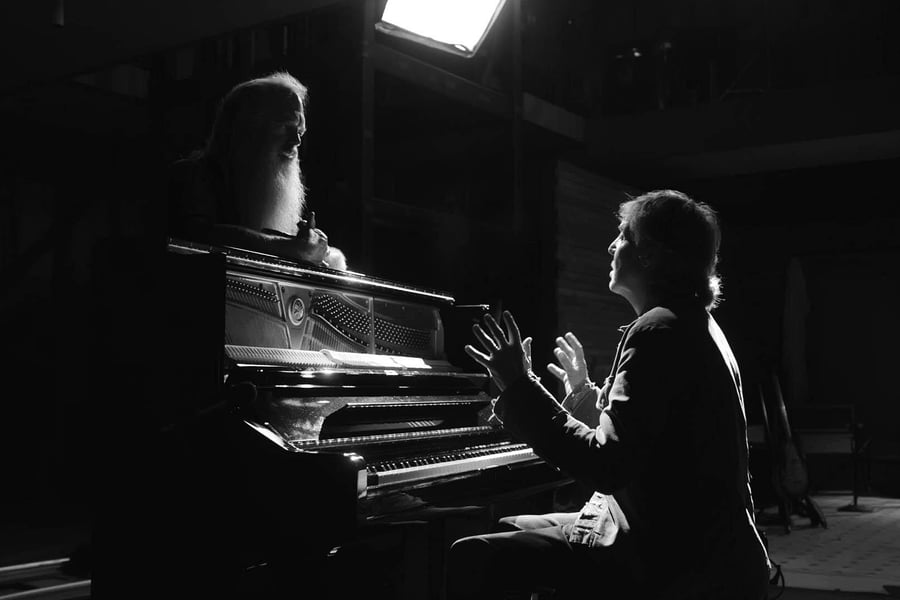Meet Paul McCartney: the ultimate Beatles geek. The excellent new Hulu documentary series McCartney 3, 2, 1 gets up close with the most legendary of rock stars, alone in the studio with Rick Rubin, telling stories and listening deep to the Beatles. It’s a fascinating thrill just to listen with him. Like anyone else, he’s mystified by how these four nowhere boys from Liverpool managed to create this music. As Paul says, “For me, I’ve grown to be a fan of the Beatles. Because then, I was just a Beatle. But now that the Beatles’ volume of work is finished, I listen back to it, and you know, ‘What’s that bassline?’”
McCartney 3,2,1 is Paul really stretching his wings as a Fabs fan. He breaks down the tunes track by track, isolating the musical details. He makes occasional (but welcome) detours into his solo and Wings years, using archival photos and film footage. Rubin, in his barefoot-Yoda mode, totally understands that his job here is to just listen and say “Wow.” It’s just three hours of conversation, stretched out over six episodes, but it flies by. This is Paul at his most charming — he’s like the barber in “Penny Lane,” giving us a tour of every mind he’s had the pleasure to blow.
One of the glorious things about Macca is that he doesn’t pretend to any kind of ambivalence about his creations; the closest he comes to a regret is the synth sound on his 1980 solo tune “Waterfalls.” He loves these songs and he loves being the guy who wrote them. As he shrugs, “Mozart once said, ‘I write the notes that like each other.’ And I like that. That sounds good to me.”
And Paul has eloquent words for his bandmates, whether he’s recalling John Lennon’s tormented childhood or how George Harrison created that “Nowhere Man” guitar shimmer. He recalls the first time Ringo Starr sat in on drums, playing Ray Charles’ “What’d I Say.” “He just lifted us,” Paul says. “He just brought the whole band together.”
It’s very Paul to give a tutorial on the making of “Maxwell’s Silver Hammer,” perhaps the Fabs’ least legendary moment. He recalls how Dr. Robert Moog was right there at Abbey Road for the session, listening to the lads try out his newly invented synthesizer. (Depending on your perspective on this much-maligned song, you might just be grateful Dr. Moog didn’t take it as a cue to set fire to his own invention.)
If you’re a Beatles fan, you’ve heard many of these stories before. But there’s always something new in them, just because he’s Paul, so intuitively tuned into music on a restless moment-to-moment level. He singles out “Here, There, and Everywhere” as his proudest moment as a songwriter — no surprise there. But it’s different when you see him listen to the track, with a grin that’s half cocky yeah-we-did-this confidence and half eerie wonder.
3,2,1 jumps right in with Paul telling Rubin about writing “All My Loving” with John on a tour bus. Since they had no recording devices, and couldn’t read music, their first priority was writing a tune they could remember the next day. “Coming from Liverpool, there’s a lot of sort of Irish Celtic influence, and the Celts never wrote anything down. It’s the bardic tradition. So that’s our excuse. Me and John used to say, ’It was the bardic tradition!’”
But the weird highlight of McCartney 3,2,1: Paul discusses the 1964 deep cut “Baby’s In Black,” one of my favorite Beatles songs, but also one of the Beatles’ favorite Beatles songs. John and Paul loved to sing this gloomy freak-folk ballad together, invariably sharing the same microphone, harmonizing eyeball to eyeball. They kept it in their live set to the end, right down to their final shows, even though they knew nobody liked it as much as they did. “We used to want to do this onstage, but it wasn’t a big fan favorite,” Paul says. “We were kind of proud of this one. We thought we were getting kind of, you know, getting into funky folk.”
But they did do it onstage, night after night, never revealing what kept bringing them back to this odd duck of a song. John and Paul heard a riddle in “Baby’s in Black” they never told anyone else about. “We started off with songs which were just for the fans — ‘From Me To You,’ ‘Love Me Do,’ ‘Please Please Me,’ ‘Thank You Girl.’ We were writing to our fan audience. But then as things went on, we started to just write for ourselves, and figured that the fans would listen to our extension of what we wanted to write. So we did and we got into slightly different things, this being 3/4 time.”
“Baby’s In Black” is a mystery, all right, but not because it’s in 3/4 time. It’s because every time you hear “Baby’s In Black,” you hear John and Paul sharing a secret they didn’t share with the rest of the world.
The Beatles were a recording band for only an eight-year period, but as McCartney 3,2,1 shows, that phase is merely where their story begins. That’s why the tunes are more legendary than ever; that’s why they don’t belong to the past. Along with all the other things they are, the Beatles are a story we keep telling each other by dreaming along with the songs. For all of us listening, we’re in the same boat as Paul — we hear the music and ask, “How is this possible?” There’s something sweet about the fact that Paul doesn’t claim to know the secret either. Like the rest of us, he’s just a Beatle fan in love with that magic feeling.
From Rolling Stone US






































